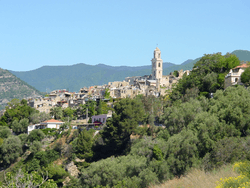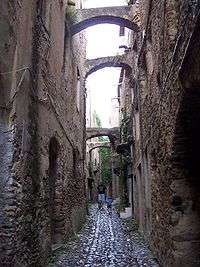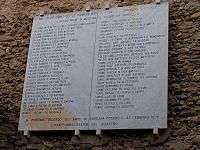Bussana Vecchia
| Bussana Vecchia | |
|---|---|
| Frazione | |
 | |
 Bussana Vecchia Location of Bussana Vecchia in Italy | |
| Coordinates: 43°50′12.47″N 7°49′47.99″E / 43.8367972°N 7.8299972°ECoordinates: 43°50′12.47″N 7°49′47.99″E / 43.8367972°N 7.8299972°E | |
| Country |
|
| Region |
|
| Province | Imperia (IM) |
| Comune | Sanremo |
| Elevation | 200 m (700 ft) |
| Population (2001) | |
| • Total | 66 |
| Demonym(s) | Bussanesi |
| Time zone | CET (UTC+1) |
| • Summer (DST) | CEST (UTC+2) |
| Postal code | 18038 |
| Dialing code | (+39) 0184 |
| Website | Official website |

Bussana Vecchia is a former ghost town in Liguria, Italy. Abandoned due to an earthquake in 1887, it was renovated and repopulated by an international community of artists in the early 1960s. It is administratively a hamlet (frazione) of the city of Sanremo, near the border with France.
History
Early history
Bussana was founded probably in the second half of the 9th century when the coastal region was repeatedly attacked by Saracens. It was built on the top of a hill to be easily defended.
In 1429 it had 250 inhabitants and it was granted autonomy from the Maritime Republic of Genoa. A period of major development followed and most of the current buildings were built in this period.
Earthquake

The French Riviera and western Liguria are at the junction of south-western Alps and Liguria basin, a region of moderate seismicity. The severest earthquake to hit Bussana struck the region on February 23, 1887 killing more than 2000 people.[1] The worst of the damage in Bussana occurred at 6:21 on that Ash Wednesday morning, a twenty-second seismic wave caused immediate destruction and deaths throughout the village.
The earthquake was the first recorded by a true seismograph built by Filippo Cecchi in Moncalieri, Italy.
Most buildings were severely damaged and the authorities decided to rebuild the village in a new site downhill called Bussana Nuova (New Bussana). The old village was abandoned and all of its buildings declared dangerous.
Rebirth
In 1947 immigrants from Southern Italy started illegally settling the ghost town. After a few forced evictions by the Italian Police in the 1950s the authorities ordered the destruction of all first floor stairways and rooftops.
Despite this in the early 1960s Vanni Giuffrè, sicilian painter, and a group of artists, the Community of International Artists (now International Artists Village), decided to move to Bussana Vecchia. The spirit of the organization was somewhat idealistic: to be able to live simply and to work artistically within the village.
In the village there was no electricity, tap water or sanitation but the new community of inhabitants grew from the small original nucleus to around twenty to thirty people by 1968, mostly hippie artists coming from all over Europe (Italian, Austrian, English, French, Danish, German and Swedish).
Tensions with the old inhabitants and with the police grew until on July 25, 1968 an eviction was ordered again and the police sent to the village to enforce it. When the police forces arrived, they were faced with the villagers behind their barricades refusing to leave and by a large group of international news reporters. The police decided to avoid confrontation.
Today
The International Artists Village was born and despite periodical confrontation with the authorities (the latest eviction order was issued in 1997 when all buildings were declared property of the Italian Government) the community is still living there, selling its handiwork to tourists, and organizing artistic events.[2]
See also
References
- ↑ "Earthquake strikes Mediterranean". Retrieved 1 November 2012.
- ↑ Artists fight for Italian village, BBC News
External links
| Wikimedia Commons has media related to Bussana Vecchia. |
- (Italian) Bussana Vecchia official website
- (Italian) Bussana and Bussana Vecchia website
- (Italian) The first Bussana Vecchia website, created in 1995
- International Artists Village official site